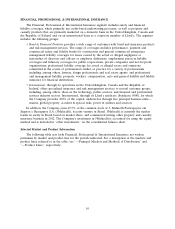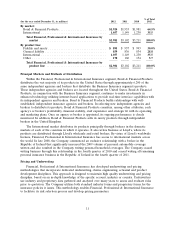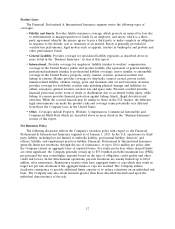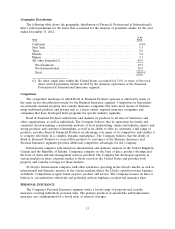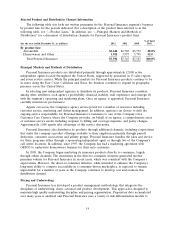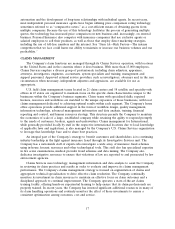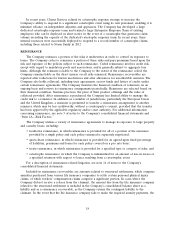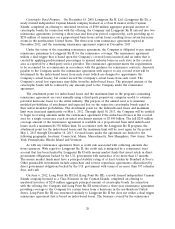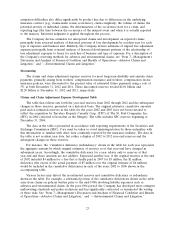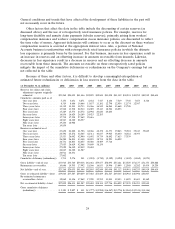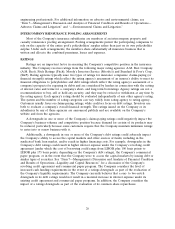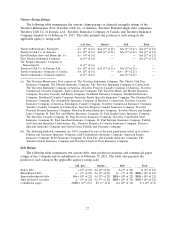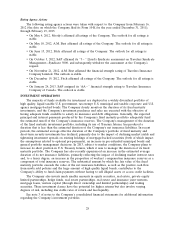Travelers 2012 Annual Report Download - page 30
Download and view the complete annual report
Please find page 30 of the 2012 Travelers annual report below. You can navigate through the pages in the report by either clicking on the pages listed below, or by using the keyword search tool below to find specific information within the annual report.In recent years, Claims Services refined its catastrophe response strategy to increase the
Company’s ability to respond to a significant catastrophic event using its own personnel, enabling it to
minimize reliance on independent adjusters and appraisers. The Company has developed a large
dedicated catastrophe response team and trained a large Enterprise Response Team of existing
employees who can be deployed on short notice in the event of a catastrophe that generates claim
volume exceeding the capacity of the dedicated catastrophe response team. In recent years, these
internal resources were successfully deployed to respond to a record number of catastrophe claims,
including those related to Storm Sandy in 2012.
REINSURANCE
The Company reinsures a portion of the risks it underwrites in order to control its exposure to
losses. The Company cedes to reinsurers a portion of these risks and pays premiums based upon the
risk and exposure of the policies subject to such reinsurance. Ceded reinsurance involves credit risk,
except with regard to mandatory pools and associations, and is generally subject to aggregate loss
limits. Although the reinsurer is liable to the Company to the extent of the reinsurance ceded, the
Company remains liable as the direct insurer on all risks reinsured. Reinsurance recoverables are
reported after reductions for known insolvencies and after allowances for uncollectible amounts. The
Company also holds collateral, including trust agreements, escrow funds and letters of credit, under
certain reinsurance agreements. The Company monitors the financial condition of reinsurers on an
ongoing basis and reviews its reinsurance arrangements periodically. Reinsurers are selected based on
their financial condition, business practices, the price of their product offerings and the value of
collateral provided. After reinsurance is purchased, the Company has limited ability to manage the
credit risk to a reinsurer. In addition, in a number of jurisdictions, particularly the European Union
and the United Kingdom, a reinsurer is permitted to transfer a reinsurance arrangement to another
reinsurer, which may be less creditworthy, without a counterparty’s consent, provided that the transfer
has been approved by the applicable regulatory and/or court authority. For additional information
concerning reinsurance, see note 5 of notes to the Company’s consolidated financial statements and
‘‘Item 1A—Risk Factors.’’
The Company utilizes a variety of reinsurance agreements to manage its exposure to large property
and casualty losses, including:
• facultative reinsurance, in which reinsurance is provided for all or a portion of the insurance
provided by a single policy and each policy reinsured is separately negotiated;
• quota share reinsurance, in which reinsurance is provided for an agreed-upon fixed percentage
of liabilities, premiums and losses for each policy covered on a pro rata basis;
• treaty reinsurance, in which reinsurance is provided for a specified type or category of risks; and
• catastrophe reinsurance, in which the Company is indemnified for an amount of loss in excess of
a specified retention with respect to losses resulting from a catastrophic event.
For a description of reinsurance-related litigation, see note 16 of notes to the Company’s
consolidated financial statements.
Included in reinsurance recoverables are amounts related to structured settlements, which comprise
annuities purchased from various life insurance companies to settle certain personal physical injury
claims, of which workers’ compensation claims comprise a significant portion. In cases where the
Company did not receive a release from the claimant, the amount due from the life insurance company
related to the structured settlement is included in the Company’s consolidated balance sheet as a
liability and as a reinsurance recoverable, as the Company retains the contingent liability to the
claimant. In the event that the life insurance company fails to make the required annuity payments, the
18




